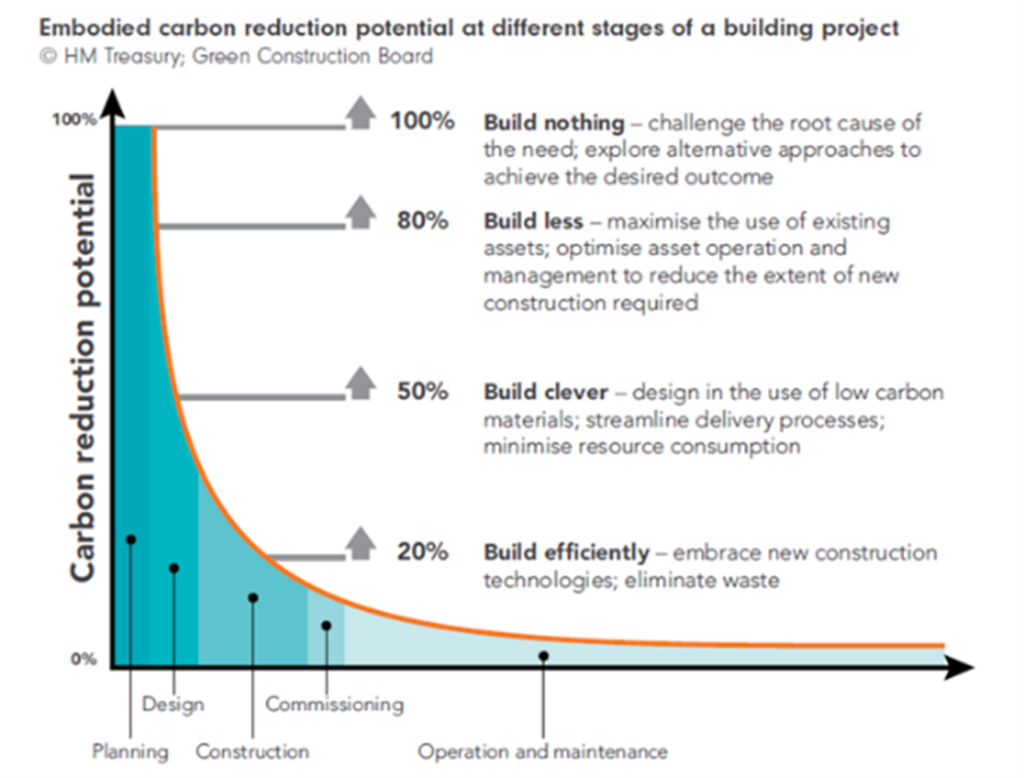How can undertaking whole-life carbon assessments at the planning stages of a project embed carbon reduction into the design process for both retrofit and development projects? Danielle Dinneen, Sustainability Consultant at Workman, and whole-life carbon-modelling expert within Workman’s ESG team, outlines the advantages.
What is a whole-life carbon assessment?
A whole-life carbon assessment captures both the operational emissions and the embodied carbon impacts of a building’s lifecycle, nominally 60 years. Operational carbon emissions include those associated with the energy and water usage while the building is in use, while embodied carbon refers to the impacts from the extraction and manufacturing of building materials; their transportation to site and the installation into the building; any maintenance, repair and replacement of materials and building services during the building lifecycle; and the eventual end-of-life emissions associated with deconstruction and disposal. Capture each of these life cycle stages to present a comprehensive view of an asset’s carbon impact throughout its entire life, whether for a new build or retrofit project.
At which stage of a project should carbon modelling be carried out?
We have the expertise for in-house whole-life carbon assessment at Workman. This supports investors and asset managers in integrating project environmental impact assessment as an integral part of their briefs. In this way, carbon reduction becomes embedded into the design process from a very early stage.
Engaging with the ESG team early is crucial. It helps in identifying redevelopment viability. Additionally, it uncovers opportunities for retrofit or reuse of existing building elements and materials. Conducting an initial comprehensive assessment during the concept design stage establishes a baseline position. This allows for showcasing iterative improvement as the project progresses.
Taking expert advice as early as possible in the feasibility process helps define whether to redevelop or retrofit. Without an initial whole life-cycle carbon assessment, the project won’t consider its full embodied carbon impact.
What are the benefits of including the whole-life carbon assessment early in the design process?
Starting at the very beginning means the opportunities and potential benefits of the recommended carbon-positive interventions can be far greater. We provide guidance to design teams on effective carbon reduction strategies. These strategies often lead to cost reductions in both the short and long term. Implementing ‘lean design’ principles, like material efficiency measures, reduces the need for raw materials, thus lowering the initial project cost.
The impact of reducing whole-life carbon follows a negative exponential curve as the project advances. Significant impact opportunities arise in the concept and early technical design stages. However, making substantial gains becomes progressively difficult and costly in later stages.
This graph, by HM Treasury’s Green Construction Board, was included in the UKGBC’s Net Zero Framework Definition.
It demonstrates the advantages of early intervention.
How does this work in practice?
Whole life carbon assessment is more than just a tick-box exercise. The assessments ought to steer decision-making towards low carbon options, constituting an integral part of the design process. We urge our clients to perform assessments during concept and technical design stages. Additionally, assessments upon practical completion showcase the savings achieved through recommended carbon reduction strategies.
After identifying the key contributing materials through assessment, we conduct optioneering exercises. During these exercises, we compare how alternative materials or construction systems impact the carbon footprint. This guides the design team in making informed decisions to achieve low carbon designs. We conduct studies to pinpoint the most favourable options. This is particularly useful when architects are considering multiple products or systems for a project. Our team can identify these advantages early in the process. This supports the client and project team in minimising emissions with minimal impact on cost and schedule. In this way, whole life carbon assessment can be a powerful tool for driving emissions reductions.
Our approach provides clients with choice. We offer a transparent menu of carbon reduction options at different price points, each delivering varying levels of carbon reduction.
For instance, in a recent early-stage assessment for a grade A office refurbishment in Central London, we identified the raised access flooring system as the primary contributor to embodied carbon emissions. It accounted for a significant 53% of upfront emissions (emissions produced prior to practical completion).
The previously specified system, produced in Italy, contributed over 19 tonnes of embodied carbon due to transportation. A thorough optioneering study pinpointed three alternative products, all manufactured in the UK. These alternatives showcased upfront carbon savings ranging from 31% to an impressive 53%.
Specifying the best materials or construction system for carbon reduction is a straightforward step for design teams. However, it requires in-depth knowledge to be specific about the manufacturers and products being deployed. That’s what we can offer. Whether we’re considering a retrofit or a new development project, through collaboration in the early stages and a considered approach to specification, it’s often simple to reduce the whole-life carbon impact quite significantly.
Do all whole-life carbon assessments follow the same process?
Historically, whole-life carbon modelling scopes haven’t all been the same, with some going further than others. Previous guidance has been open to interpretation with different organisations and carbon target frameworks prescribing differing scopes, leading to incomparable results, and hindering the development of aligned industry carbon targets.
The RICS have recently published their revised Professional Statement on Whole Life Carbon Assessment for The Built Environment, providing a comprehensive framework for assessment of whole life carbon emissions which will allow the industry to align their reporting, leading to more accurately comparable results. The new RICS whole life carbon assessment scope will align with the soon-to-be-published UK Net Zero Carbon Buildings Standard (NZCBS), which will provide sector targets for embodied carbon and energy use that are aligned with the UK national carbon budget and will need to be met if an asset is to be declared Net Zero carbon.
The RICS guidance is due to come into effect at the beginning of July 2024, in part to allow software developers to integrate the new requirements into their LCA tools. While it will not be possible to fully align reporting to the new guidance until these tools have been updated, we will be reporting to the full scope and boundaries prescribed by the RICS in the interim period to manage the transition and ensure our early-stage reports will be comparable with later assessments and projects.
We will additionally be encouraging our clients to report the results of their assessments to the new Built Environment Carbon Database (BECD), which will gather the data necessary to develop and refine future targets and industry benchmarks.
How does whole-life carbon assessment fit into BREEAM?
BREEAM assessments are valuable for compliance and can earn points. However, their scope is limited, focusing on major elements such as superstructure and substructure. They might not encompass finishes or furniture, fixtures, and equipment, and therefore, may not provide an accurate account of the lifecycle embodied carbon impacts. BREEAM assessments can provide valuable points when pursuing compliance, but aren’t suitable for use as a real-world carbon reduction tool. In contrast, our assessments are intended to give a holistic, comprehensive and realistic position on carbon so that our clients can offset any remainder to achieve Net Zero under the UK Green Building Council Framework, and the future NZCBS when this comes into effect.
Are clients recognising the benefits of whole-life carbon assessments?
Whole-life carbon assessment is a science-based methodology which provides an accurate position on the carbon emissions of an asset, going beyond compliance. We work to inform design teams and give them accurate figures so that they can implement carbon reduction strategies that actually work.
There is a clear shift in the industry: investors are alive to the idea that we need to be dealing in actual figures rather than purely complying with building regulations or ticking boxes for green building badges, if we want to bring real, positive, and sustainable change to the built environment. The Workman ESG team can help them achieve this.
Danielle Dinneen has extensive experience in modelling carbon emissions and producing whole-life carbon assessments within the built environment. Danielle holds an MSc in Green Building, Sustainability & Adaptation in the Built Environment, along with a BSc in Architectural Technology & Design.





